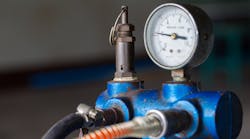6 ways to improve the design of your rotary screw compressed air system
Robert Horneman, product manager at ELGi North America, said that anybody that makes anything uses compressed air, just like they would use electricity. Most in manufacturing consider compressed air the fourth utility. “It’s also the only utility that’s actually made by the customer,” Horneman said.
Manufacturers are often experts at making their own products but aren’t always experts in making compressed air. “There’s often a lot of opportunity for improving the efficiencies of it,” Horneman added. Here are six tips for improved system design on a rotary screw air compressor.
1. Variable speed drive compressors can save energy
Typical compressed air usage is not constant. “It goes up and down, up and down, over the course of a day, depending on what machines they have on, depending on what products they’re running through their line,” Horneman said. The variable speed drive will slow the compressor down when usage is down, which saves time and energy. This energy saving feature can pay for itself in months, Horneman added. “It’s not unusual to have a variable speed drive because very quickly you can show a payback on that technology,” he added.
2. The larger the rotors in the air end, the more reliable and energy efficient the compressor
The air end in a compressor is the screws that do the actual compression. “It’s the heart of the compressor,” Horneman said. “It’s really what drives the whole thing.” ELGi is a vertically integrated business, meaning it manufactures all its own parts, including air ends with extremely tight tolerances. “These rotors are twisting together; that’s what creates the compression, and they’re actually very large, and why that’s important is because they’re large, they can spin slower,” Horneman said. A smaller air end has to spin faster to produce the same amount of flow, which creates more wear and tear. The larger rotors also use less energy to create the same amount of compressed air.
3. Air quality is dependent on the air and the oil carryover from the compressor
“When you bring in ambient air into the compressor package where the rotors spin together, there’s oil inside that compression chamber. The oil seals the distance between the rotors and the housing, so it makes it more efficient,” Horneman said. The issue with that process is that the compressed air coming out is also impregnated with oil, so it travels to an air-oil separator. With a baffle where the air and oil enter the separator, this starts the mixture spinning through the separator tank, and the centrifugal force throws the oil to the outside of the tank. The oil gets picked up at the bottom of the separator tank and is fed back into the air end. The rest of the air travels through additional elements that further filter and fine tune the air before it goes to the plant. At 1 parts per million (ppm) of oil carryover, if a plant runs the compressor for 4,000 hours, a 500 cfm compressor at 100 hp, is only going to have 1.1 gallons of oil come out of the system. Some systems can run as high as 12 gallons of oil over 4,000 operating hours. “That makes a massive difference on the environment; it makes a massive difference on how much oil they have to put back into the machine to keep on running,” Horneman said.
4. Pressure costs efficiency and money
Compressed air is a cost-intensive utility because all the equipment that filters and cleans oil and moisture comes at the cost of pressure drop. “The higher the pressure means that the compressor has to use more kilowatts to create it,” Horneman said. “To raise your compressor by 2 psi, you have to raise the energy to do that by 1%. Likewise, if you can reduce it by 2 psi, you’ve just saved yourself 2%.” Certain filters have lower pressure drop than others, depending on the application. Hoses can also create massive pressure drop, so don’t use a 30-foot hose, where a five-foot hose will work.
5. Controllers can help identify maintenance periods
Filters and oil need to be periodically changed. This process can be automated by controllers within the compressor that notify maintenance teams. The air dryer typically doesn’t have a lot of maintenance associated with it, Horneman said, but the display can show the moisture content, in case it starts to go up. Be aware if there’s ambient dirt in the air dryer, it can cause overheating. The key pieces of equipment that need regular maintenance are the particulate, fine and carbon filters. The more dirt that builds up in these filters, the more pressure it creates. “There’s a little gauge on there that shows you when that pressure starts going up and shows when it’s time to change the filter,” Horneman said.
6. An oversized split cooler design provides larger surface area and more cooling power
Compressors make a lot of heat, which means air can’t be sent directly downstream without cooling. Many of the filters or air dryer elements could not survive such a high heat load. With an oversized split cooler design, a thicker tank saves energy. The cooling fan doesn’t have to be as large because the fins have much larger surface area. The split design receives oil on one side and air on the other, after it has been separated. This is important because air and oil cool at different rates; with a solid piece design, the temperature differences can create thermal stress along that joint. However, separation between the coolers doesn’t create long-term stress that could lead to damage.

